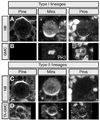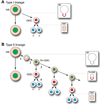Identification of Drosophila type II neuroblast lineages containing transit amplifying ganglion mother cells
- PMID: 18548484
- PMCID: PMC2804867
- DOI: 10.1002/dneu.20648
Identification of Drosophila type II neuroblast lineages containing transit amplifying ganglion mother cells
Abstract
Mammalian neural stem cells generate transit amplifying progenitors that expand the neuronal population, but these type of progenitors have not been studied in Drosophila. The Drosophila larval brain contains approximately 100 neural stem cells (neuroblasts) per brain lobe, which are thought to bud off smaller ganglion mother cells (GMCs) that each produce two post-mitotic neurons. Here, we use molecular markers and clonal analysis to identify a novel neuroblast cell lineage containing "transit amplifying GMCs" (TA-GMCs). TA-GMCs differ from canonical GMCs in several ways: each TA-GMC has nuclear Deadpan, cytoplasmic Prospero, forms Prospero crescents at mitosis, and generates up to 10 neurons; canonical GMCs lack Deadpan, have nuclear Prospero, lack Prospero crescents at mitosis, and generate two neurons. We conclude that there are at least two types of neuroblast lineages: a Type I lineage where GMCs generate two neurons, and a type II lineage where TA-GMCs have longer lineages. Type II lineages allow more neurons to be produced faster than Type I lineages, which may be advantageous in a rapidly developing organism like Drosophila.
(c) 2008 Wiley Periodicals, Inc. Develop Neurobiol, 2008.
Figures





References
-
- Bello B, Reichert H, Hirth F. The brain tumor gene negatively regulates neural progenitor cell proliferation in the larval central brain of Drosophila. Development. 2006;133:2639–2648. - PubMed
-
- Bello BC, Hirth F, Gould AP. A pulse of the Drosophila Hox protein Abdominal-A schedules the end of neural proliferation via neuroblast apoptosis. Neuron. 2003;37:209–219. - PubMed
-
- Betschinger J, Mechtler K, Knoblich JA. Asymmetric segregation of the tumor suppressor brat regulates self-renewal in Drosophila neural stem cells. Cell. 2006;124:1241–1253. - PubMed
-
- Bier E, Vaessin H, Younger-Shepherd S, Jan LY, Jan YN. deadpan, an essential pan-neural gene in Drosophila, encodes a helix-loop-helix protein similar to the hairy gene product. Genes Dev. 1992;6:2137–2151. - PubMed
Publication types
MeSH terms
Substances
Grants and funding
LinkOut - more resources
Full Text Sources
Medical
Molecular Biology Databases

